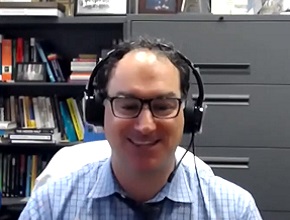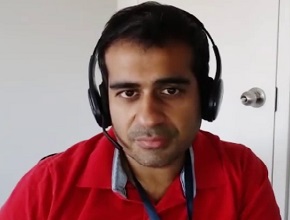Dr Bram Rochwerg, associate professor in the Division of Critical Care Medicine at McMaster University and coauthor of the World Health Organization (WHO) living coronavirus disease 2019 (COVID-19) guidelines, and Dr Roman Jaeschke scrutinize current evidence on the use of a novel drug, molnupiravir, in the early treatment of COVID-19.
For a Publications of the Week article discussing the use of molnupiravir in COVID-19, click here.
Roman Jaeschke, MD, MSc: Good afternoon. Welcome to another edition of McMaster Perspective. I would like to reintroduce Dr Bram Rochwerg, who is our critical care and COVID-19 expert. Bram, maybe we will start by [you] introducing yourself and your role in the current review of evidence and practice guidelines. Could you tell us what that is about?
Bram Rochwerg, MD, MSc: Thanks, Roman. Thanks for having me again. I am an adult intensive care unit (ICU) doctor at McMaster University in Hamilton, but I also work with the MAGIC group in supporting the WHO living COVID-19 guidelines. We have now, for the last 1.5 or 2 years, made, I think, 7 or 8 different recommendations as part of the WHO guidelines and I’ve acted as the methods chair for those guidelines. And [in] the most recent one we’ve just addressed—we have not published [them] yet, but [we] have a draft recommendation in place for molnupiravir, which I think we’re going to discuss today. I’ve worked with the WHO in coming up with these evidence-based guidelines.
Roman Jaeschke: Being a methods chair means you have to control all the clinicians who have very strong opinions, right?
Bram Rochwerg: Yes, I am fortunate to have a great group. You know, it’s truly international, including patient representatives, and they get to work alongside some fantastic clinical chairs as well. Each of the panels has a methods chair and a clinical chair and we work together to moderate the discussion amongst the group.
Roman Jaeschke: So, molnupiravir… I hoped that I would never need to learn all those exotic names, but it sounds like we do. I wonder if you could summarize the evidence, which is the front entry to any practice guidelines, and maybe you could start by the origin of the name?
Bram Rochwerg: As I was telling you, it’s actually named after Thor. You know, the Norse god Thor—his hammer is called Mjölnir. And they named the drug after Thor’s hammer. It was the effect, I guess, it was supposed to have on COVID-19 by hammering it down.
Roman Jaeschke: So, what effect does it have?
Bram Rochwerg: In support of the WHO living guidelines we also have a living network meta-analysis. This is coordinated by folks at McMaster, Reed Siemieniuk and Romina Petersen-Brignardello, [these are] the 2 [people] who lead this effort. They’ve summarized the evidence around molnupiravir. It’s gotten a lot of attention in the media in the last little while, and this is culminated in the publication of the MOVe-OUT trial in the New England Journal of Medicine (NEJM) just in the last few days, in fact. However, most of the trial data is done in outpatients early in their course of COVID-19, and the summary of the data does demonstrate a fairly significant reduction in the need for hospitalization, about a 50% reduction, as well as a reduction in the time to symptom improvement. You know, there’s data to suggest that it might have an impact on mortality, but given the fact that this has been studied in outpatients, the number of events, number of deaths in the studies were very, very low. So, [it’s] hard to say much in terms of mortality, but certainly, again, a major impact on the reduction in the need for hospitalization.
Roman Jaeschke: “A major impact,” again, the best estimate of the effect is… What are we talking about?
Bram Rochwerg: About a 50% reduction and the confidence intervals… they range from about a 70% reduction to a 10% reduction. But the point estimate was a 50% reduction in hospitalization.
Roman Jaeschke: And I understand talking to our provincial colleagues that prevention of hospitalizations is probably the most important [item] on their agenda with the health-care resources.
So, should we start using it? Or maybe before we even go there: there were some issues of an interim analysis, there were some issues of a subgroup analysis. Was that part of discussion among your panel?
Bram Rochwerg: It certainly was. For those who aren’t aware: the makers of molnupiravir, the industry partners, published or made open their interim analysis after 50% of patients were enrolled, which showed an even more dramatic reduction in hospitalization. Only once all the patients were enrolled, when they released their final results, it was a more modest reduction in hospitalization. And although much was made of this, we did discuss it. Any time you do an interim analysis—and I learned this, Roman, from you, and from Gordon Guyatt, and my methodologic mentors—any time you do interim analysis, there’s risk of catching an overexaggeration or an underexaggeration of the effect [and] only once you meet the totally powered sample, do you see the true effect.
It’s sort of akin to… I’m a sports fan. If your favorite sports team goes out and wins their first 10 games, you might overreact and say, “Oh my God, this is the best team ever. They’re going to win the championship this year!” And then, when you finish the season and you see that they lost their next 10 games and ended up in about an equal number of wins and losses, you realize that that was just a finding of chance that they had won those first 10 games. It is sort of similar here that we probably caught early interim analysis that overexaggerated that benefit. But the overall [results] show the true benefits.
Roman Jaeschke: And how about the subgroups? People put attention to a subgroup of patients who had previous infection, a subgroup of patients with different severity of the disease… Did you look at the possible modifiers of the effect?
Bram Rochwerg: We did and I know that a couple of them were reported in the paper. We evaluated all of these subgroups and found no evidence of a high-credibility subgroup effect. And we used a tool called the ICEMAN, which was validated by researchers at McMaster, including Gordon Guyatt and one of his PhD students, which is based on certain parameters, evaluates how reliable subgroup findings are.
When evaluating all of those subgroups you’ve mentioned, including the one about antibody positivity in previous infection, we found no evidence of relative subgroup effects, which means that the drug works similarly across subgroups. That being said, Roman, of course, those at higher risk of hospitalization, higher risk of death, are going to have a greater absolute effect, a bigger reduction in hospitalization as compared to those who are at lower risk of disease.
Roman Jaeschke: A larger absolute reduction, lower number needed to treat, more effect for the expense, and so forth, as opposed to relative risk, which, as we know, usually stays stable across different populations. So effectively, what you’re saying is it should work in relative terms similarly across populations, or at least you didn’t find evidence that it works differently.
Bram Rochwerg: That’s exactly right. Although, you know, the mindset—the majority of the trials enrolled patients early in their course of illness—and given its mechanism of action as an antiviral… suffice to say is that we think, in terms of subgroups, that probably the earlier you administer this drug, the more likely it is to have a beneficial effect. The majority of the included trials gave molnupiravir within the first 5 days of symptom onset and some of them even slightly [earlier], around 3 or 4 days of symptom onset.
Roman Jaeschke: So, it would probably be difficult to extend it to the hospitalized population, you know, using one antiviral orally versus intravenously.
Bram Rochwerg: That’s exactly right. I think that the viral replication stage happens earlier on in the course of illness, probably in the first few days [to a] week following infection. And then, once you get into the stage where patients deteriorate clinically, get sicker, this is the more inflammatory stage and probably why [what] we see more [often] in hospitalized patients is the benefit of anti-inflammatory agents like steroids and interleukin-6 (IL-6) receptor blockers, whereas antivirals, if they’re going to work, [they] are going to work more efficaciously early on in disease.
Roman Jaeschke: Some of my colleagues were interested in… and maybe, if you have an overview of other potentially pre-admission ambulatory treatments, especially inhaled corticosteroids, or budesonide specifically, or colchicine, is your group discussing relative values or the relative level of confidence in the effectiveness of those interventions?
Bram Rochwerg: Certainly the network meta-analysis design allows one to evaluate relative effectiveness of different interventions. [Despite] early enthusiasm for colchicine, subsequent trials have not shown a consistent reduction in hospitalization and improved outcomes with colchicine. Inhaled budesonide [is] one that potentially shows promise and we plan to evaluate [it] with the WHO in the upcoming months. Still, at this stage, the trials are relatively small and looking at primarily more surrogate outcomes but perhaps building an evidence base for this drug.
But I think, especially when you consider an inhaled corticosteroid versus antiviral, there’d be no concerns about coadministration in this case and [these] could be looked at individually. Maybe the one that could be important is this more recently released Pfizer antiviral. And I think, as we continue to consider this drug and the role for molnupiravir versus this other drug, there might be room for more discussion.
Roman Jaeschke: This other drug is called nirmatrelvir and ritonavir combination, I guess. Are you planning to look at that particular drug? It was just approved by the United States Food and Drug Administration (FDA) 2 days ago.
Bram Rochwerg: Absolutely. We plan to look at that one soon, and it’s possible that there could be some benefits to this one over molnupiravir. You know, we’ve talked about the benefits of molnupiravir, but I think I was mentioning to you that there [are] harms associated with molnupiravir as well.
Roman Jaeschke: Real harms or potential harms?
Bram Rochwerg: Perhaps potential… maybe a mixture of both, the main ones being… Given [the] antiviral effect specific to molnupiravir and how it works [as a] nucleoside analogue, there’s a concern from pharmacologists and biochemists that it might induce resistance in the virus; resistance to molnupiravir and to other antivirals, and that might have an impact in the future on our ability to treat.
The other major one is mutagenesis, and it’s actually risks to the unborn fetus, risks [of] germline and somatic mutations, both for men and women. So, those who are pregnant, breastfeeding cannot take this drug, [there is] even suggestion that those who are in the reproductive age need to be very, very careful, on contraception, and maybe even a suggestion that those <50 [years] should avoid taking this medication.
Roman Jaeschke: Below 50… OK… Bram, I understand you had 2 major panel meetings on it. How many people are there on the panel? The one that decides what the recommendations will be?
Bram Rochwerg: I think there are about 30 voting members on the panel [that gives] extra support to the WHO.
Roman Jaeschke: And who are they? Not the names, obviously, but what professions are involved?
Bram Rochwerg: You know, it’s humbling being on these calls, Roman. There’s folks [from] across the breadth of multidisciplinary practice—physicians [from] amongst all sorts of fields: infectious diseases (IDs), critical care medicine, pediatrics, public health, family doctors, etc; ethicists, pharmacologists, methods experts—you know, a representation [that is] truly international. We have folks on the call and you can see in the background [that] in some [countries] it’s 3:00 in the morning where they are. Others [have] the middle of the day. We have folks from low- and middle-income countries and from high-income countries. It’s quite amazing.
Roman Jaeschke: We were not talking about the cost of the drug, which may also be an issue. Say that you will come with recommendations “for”—what kind of barriers could there exist to the implementation of a widespread use of different medications for COVID-19, specifically molnupiravir? Do you consider those issues?
Bram Rochwerg: We certainly consider and I think there are similar issues when it comes to molnupiravir as there have been for other specific drugs like IL-6 receptor blockers and others: the cost and access. You know, as the pharmaceutical companies are producing these, they certainly are interested in getting them to places—markets—where they’re going to make a profit and [are] reluctant to widespread dissemination at a cheaper value. So, I think the major ones certainly [oscillate] around cost and access, and those are definitely present here with molnupiravir as well.
Roman Jaeschke: I understand the publication will occur in a few weeks. What can you tell us now about what the recommendation will be? I understand you cannot be direct.
Bram Rochwerg: Yeah. I don’t think I can. It’s embargoed until it’s made. But you know, this was one of our recommendations that [had] a very close balance of benefits and harms; the reduction in hospitalization is important, 50%, and you’ve already alluded to… this is a patient-important outcome, but also an important outcome to resources, hospital resources. However, you know, the harms, the concerns around resistance, around the impact on fetus and mutagenesis are also important. And then the other side of things is that, you know, we don’t know what molnupiravir activity is going to be against the new variants like Omicron. There’s now a situation, thankfully, where we have multiple other options, including remdesivir as well as the new Pfizer product, and where this [agent] fits in with other agents. So, you know, when we factored all of this in, it came down it was a very close and debated discussion around a recommendation for or against.
Perhaps I can’t mention exactly where we ended up, but I think that the main takeaway is that this is going to be a drug that is going to require very careful, shared decision making between the physician and the patient, weighing these pros—the benefits—and the harms, and deciding whether this is something for individuals to take.
Roman Jaeschke: Bram, in the end, you’ve just made yourself a number of future interviews, both on budesonide, and Paxlovir, and all the other stuff—maybe we should set up a monthly meeting? In the meantime, I know that you’re on the call in the ICU and now you will run. All the best to you and thank you so much for sharing your expertise. It’s fantastic that you have it and that we can get a piece of it. Thank you.
Bram Rochwerg: Thanks for the opportunity. Take care.
Roman Jaeschke: Thank you. Goodbye.
 English
English
 Español
Español
 українська
українська











